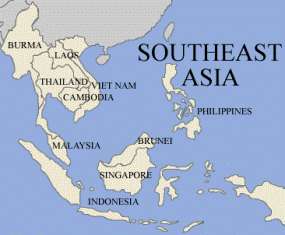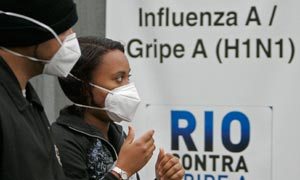|
The World Health Organization (WHO) is a specialized agency of
the United Nations (UN) that acts as a coordinating authority on
international public health. Established on 7 April 1948, and
headquartered in Geneva, Switzerland, the agency inherited
the mandate and resources of its predecessor, the Health Organization,
which had been an agency of the League of Nations. WHO has 6
regional offices (African Region, Region of the Americas–PAHO,
South-East Asia Region, European Region,
Eastern Mediterranean Region and Western Pacific Region).
The World Health Organization Regional Office for South-East Asia
(WHO/SEARO) has 11 member countries which consist of Bangladesh, Bhutan,
Democratic People's Republic of Korea, India, Indonesia, Maldives, Myanmar,
Nepal, Sri Lanka, Thailand, Timor-Leste. The WHO/SEARO’s head quarter
is located in New Delhi, India.
Objectives
The objective of the World Health Organization (hereinafter
called the Organization) shall be the attainment by all peoples of the highest
possible level of health, the functions of the Organization shall be:
- To act as the directing and co-ordinating authority on international health work
- To establish and maintain effective collaboration with the United Nations,
specialized agencies, governmental health administrations, professional groups
and such other organizations as may be deemed appropriate
- To assist Governments, upon request, in strengthening health services
- To furnish appropriate technical assistance and, in emergencies, necessary aid
upon the request or acceptance of Governments
-
To provide or assist in providing, upon the request of the United Nations,
health services and facilities to special groups, such as the peoples of trust territories
- To establish and maintain such administrative and technical services as may be
required, including epidemiological and statistical services
- To stimulate and advance work to eradicate epidemic, endemic and other diseases
- To promote, in co-operation with other specialized agencies where necessary, the
prevention of accidental injuries
- To promote in co-operation with other specialized agencies where necessary, the
improvement of nutrition, housing, sanitation, recreation, economic or working
conditions and other aspects of environmental hygiene
- To promote co-operation among scientific and professional groups which contributes
to the advancement of health
- To propose conventions, agreements and regulations, and make recommendations with
respect to international health matters and to perform such duties as may be assigned
thereby to the Organization and are consistent with its objective
- To promote maternal and child health and welfare and to foster the ability to live
harmoniously in a changing total environment
- To foster activities in the field of mental health, especially those affecting the
harmony of human relations
- To promote and conduct research in the field of health
- To promote improved standards of teaching and training in the health, medical and
related professions
-
To study and report on, in co-operation with other specialized agencies where necessary,
administrative and social techniques affecting public health and medical care from
preventive and curative points of view, including hospital services and social security
- To provide information, counsel and assistance in the field of health
- To assist in developing an informed public opinion among all peoples on matters of health
- To establish and revise, as necessary, international nomenclatures of diseases, of
causes of death and of public health practices
- To standardize diagnostic procedures as necessary
- To develop, establish and promote international standards with respect to food, biological,
pharmaceutical and similar products
- Generally to take all necessary action to attain the objective of the Organization
Background
Before the Second World War, the term "South-East Asia" was scarcely
a geographic expression and was rarely used. The region of the peninsula between India
and China was included in the term "Far East". Some authors called the region "Further India".
During the Second World War, the Japanese Army used the term "Greater East Asia" to
include countries of South-East Asia.

The term "South-East Asia" is credited to the Indian historian K.M. Pannikar who used
it in the title of his book "Future of Southeast Asia" published in 1943. Due to military
and strategic considerations during the Second World War, the region came to be regarded
as a separate geographic entity and the Allied Supreme Command adopted the term
"South-East Asia". By the end of the war, the term was well established and was used as
a collective for the peninsula between India and China. The countries include Brunei,
Myanmar, Thailand, Laos, Cambodia, Vietnam, Malaysia, Singapore and Indonesia. Some organizations
include the Phillipines in South-East Asia.
Countries in and adjacent to the Indian subcontinent, namely, India, Pakistan, Bangladesh,
Nepal, Bhutan, Sri Lanka and Maldives are considered as belonging to "South Asia"
When the formation of the World Health Organization was being discussed, the Interim
Commission of the World Health Organization made some preliminary inquiries from governments
concerning their views on the delineation of areas for the regional organization of WHO.
The First World Health Assembly set up a Committee in 1948 to consider the delimitation of the
geographical areas. After much debate, the Committee recommended to the Assembly to delineate
the areas as: Europe, Middle East, Near East and parts of North-East Africa; South-East Asia;
the Far East; and Africa. The area for the Americas was included later.
The Assembly by a resolution, delineated six geographic areas for regional organizations
as follows:
- Eastern Mediterranean
- Western Pacific
- South-East Asia
- Europe
- Africa (South of the Sahara)
- The Americas
The following countries were considered as belonging to
the South-East Asia Region e.g. Afghanistan, Myanmar, Ceylon (Sri Lanka),
India and Siam (Thailand). The designation of the countries to the
South-East Asia Region thus did not follow the generally accepted definition
of South-East Asia. The Assembly in its recommendations for grouping had considered
several factors. However, these criteria could not and were not applied consistently
and no uniform method was employed to delineate the regions. The American and European
regions were defined to include whole continents; the African Region was based partly
on political frontiers and partly on geographic frontiers. For the Eastern Mediterranean,
South-East Asia, and the Western Pacific Region, the states and territories were enumerated.
States, which were not included in this enumeration, or new Member States were assigned
to the various regions by the Assembly. But the States could also request transfer
from one region to another.
The original five members of the South-East Asia Region were:
Afghanistan, Myanmar, Ceylon (Sri Lanka), India and Siam (Thailand). These countries
had signified their consent at the First World Health Assembly in 1948 to join the
South-East Asia Region when it was established.

By a resolution of the Second World Health Assembly, representatives
of Member States of WHO, not having their seat of government within the Region but
responsible for the conduct of international relations for territories which were
within the Region, were allowed to attend the Regional Committees. It was, thus,
that in the South-East Asia Region, France (representing French India), Portugal
(representing Portuguese India) and the United Kingdom (representing the Maldive Islands),
attended the meetings of the Regional Committee for South-East Asia, from the second
to the sixteenth sessions. French and Portuguese territories in India became part of
the Republic of India in 1954 and 1961 respectively. The Maldive Islands became
independent in 1965.
The original Assembly resolution in 1948 had placed Indonesia in
the Western Pacific Region. But in 1950, when Indonesia joined WHO, it was transferred,
at its own request, to the South-East Asian Region.
The Republic of Vietnam and the Kingdoms of Cambodia and Laos
were also originally included in the South-East Asia Region by a resolution of the
Third World Health Assembly. But when the Western Pacific Regional Office was
established in 1951, these three countries opted to join that Region.
The Kingdom of Nepal became a member of the World Health Organization
on 2 September 1953 and was formally included in the South-East Asia Region by a resolution
of the World Health Assembly in 1953.
The next country to become a member of the South-East Asia Region
was the Mongolian People's Republic. It became a member of WHO on 18 April 1962,
and although not belonging geographically to South or South-East Asia, it requested
to be allowed to join this Region. This was formally approved by the Fifteenth World Health
Assembly. However from 1 July 1995, Mongolia separated from the South-East Asia Region
and joined the Western Pacific Region.
Maldives became independent on 26 July 1965. It became a member
of WHO on 5 November 1965 and joined the South-East Asia Region.
In 1969, Afghanistan, one of the original members of the South-East
Region, was transferred at its request and the approval of the Assembly to the Eastern
Mediterranean Region because of geographical contiguity and for political reasons.
Bangladesh was East Pakistan at the time of independence of India and
Pakistan in 1947. In December 1971, it gained independence and became the People's
Republic of Bangladesh. It became a member of WHO on 19 May 1972 and joined the South-East
Asia Region.
The Democratic People's Republic of Korea became a member of WHO on 19 May 1973,
the first UN agency the country joined. It opted to join the South-East Asia Region.
The Kingdom of Bhutan joined WHO on 8 March 1982.
The most recent Member State to be included in the Region is the
Republic of Timor Leste which joined WHO on 27 September, 2002, and opted for joining
the South-East Asia Region in May 2003.
In September 1988 the Union of Myanmar was named as the Union of Myanmar.
There are now eleven Member States in the WHO South-East Asia Region.
They are listed below with the date which they became a party of WHO's Constitution:
|
South-East Asia Region WHO's constitution
| Country |
Date |
Bangladesh |
19 May 1972 |
Bhutan |
08 March 1982 |
Democratic People’s Republic of Korea |
19 May 1973 |
India |
12 January 1948 |
Indonesia |
23 May 1950 |
Maldives |
05 November 1965 |
Myanmar |
01 July 1948 |
Nepal |
02 September 1953 |
Sri Lanka |
07 July 1948 |
Thailand |
26 September 1947 |
Timor-Leste |
27 September 2002 |
|
Link to: http://www.searo.who.int/index.htm
|


